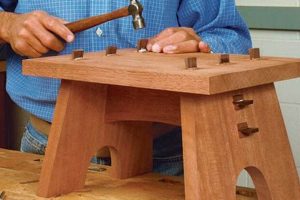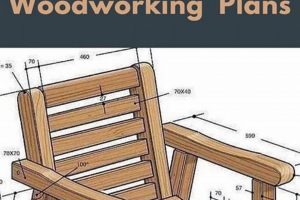Constructions involving the creation of wooden objects that incorporate moving parts or automated functions constitute a distinct subset within woodworking. These endeavors frequently integrate principles of mechanics and engineering to achieve motion or specific functionalities. Examples include automata, gear-driven mechanisms, and complex kinetic sculptures fashioned primarily from wood.
The significance of this approach lies in its capacity to blend artistic expression with practical mechanics, resulting in engaging and interactive creations. Historically, such projects have served as demonstrations of ingenuity and craftsmanship, showcasing the potential of wood as a versatile engineering material. The development of these intricate devices fostered a deeper understanding of mechanical principles and precision woodworking techniques.
This exploration will delve into the various techniques and tools employed in constructing these dynamic wooden artifacts. Subsequent sections will address design considerations, material selection, and methods for assembling complex moving components. Furthermore, the article will provide insights into troubleshooting common challenges encountered during the construction process.
Essential Considerations for Mechanical Woodworking
Achieving successful outcomes in projects that integrate mechanical elements requires meticulous planning and execution. The following points highlight crucial areas for consideration during the design and construction phases.
Tip 1: Precision in Design: Prioritize detailed schematics and precise measurements. Mechanical functionality is highly dependent on accurate dimensions. Employ CAD software or detailed hand drawings to ensure dimensional integrity.
Tip 2: Wood Selection and Grain Orientation: Select wood species appropriate for the intended application. Consider the wood’s density, stability, and resistance to wear. Grain orientation should be carefully considered to maximize strength and minimize warping in moving components.
Tip 3: Joint Integrity: Employ robust joinery techniques, such as mortise-and-tenon or dovetail joints, to ensure the structural integrity of moving parts. Loose or poorly fitted joints will negatively impact the functionality and longevity of the project.
Tip 4: Friction Mitigation: Minimize friction in moving parts through proper lubrication or the incorporation of low-friction materials. Consider the use of wax, graphite, or self-lubricating bushings to reduce wear and enhance performance.
Tip 5: Precise Alignment: Implement accurate alignment methods during assembly to ensure smooth and consistent motion. Misalignment can cause binding, increased friction, and premature wear. Jigs and fixtures can be invaluable for achieving precise alignment.
Tip 6: Consider Drive Mechanisms: Select a suitable drive mechanism based on the project’s requirements. Options include gears, cams, levers, and linkages. Each mechanism has unique advantages and disadvantages in terms of efficiency, complexity, and precision.
Tip 7: Testing and Refinement: Thoroughly test the mechanical functionality of the project throughout the construction process. Identify and address any issues related to friction, alignment, or structural integrity. Iterative refinement is crucial for achieving optimal performance.
Adhering to these guidelines can significantly enhance the functionality, durability, and overall success of involved endeavors. Attention to detail in design, material selection, and construction methods is paramount.
The subsequent sections will explore advanced techniques and specialized tools employed in these intricate woodworking practices, offering a deeper understanding of its nuances and potential applications.
1. Motion Transmission
Motion transmission is a foundational element in constructions that involve moving wooden parts, enabling the controlled transfer of mechanical energy to achieve desired functions. Effective motion transmission is pivotal for the functionality and performance of these projects, influencing both their aesthetic appeal and operational efficiency.
- Gears and Gear Trains
Gears serve as fundamental components for motion transmission, facilitating the alteration of speed, torque, and direction of rotational motion. In geared devices, the precise meshing of gear teeth ensures a controlled and predictable transfer of power. Variations in gear size ratios enable specific speed and torque adjustments, crucial in automata and other mechanical wooden devices. Inaccurate gear design or construction can lead to inefficient transmission and premature failure of the mechanism.
- Linkages and Levers
Linkages and levers are employed to convert linear motion to rotational motion or vice versa. In constructions, levers can provide mechanical advantage, amplifying force to achieve desired movements. Linkages, composed of interconnected rigid bodies, offer a versatile means of transmitting motion along complex paths. The accurate design and assembly of linkages are critical for achieving the intended kinematic behavior of the device. Examples of linkages include crank-rocker mechanisms, slider-crank mechanisms, and four-bar linkages.
- Cams and Followers
Cams and followers are used to create specific motion profiles. A cam, with its precisely shaped profile, drives a follower, translating its rotary motion into linear or oscillating motion. This is commonly found in automata to create intricate movement sequences. The cam’s shape dictates the follower’s motion, demanding careful design and fabrication. Proper lubrication and material selection are essential to minimize wear between the cam and follower surfaces.
- Belt and Pulley Systems
Belt and pulley systems offer a flexible means of transmitting rotational motion over distances. These systems consist of a belt connecting two or more pulleys, facilitating the transfer of power between rotating shafts. They are typically used when axes of motion are not adjacent or when a degree of flexibility is desired. The diameter ratio of the pulleys determines the speed and torque relationship between the connected shafts. Belt tension is crucial for efficient power transmission; excessive tension can lead to premature wear, while insufficient tension can cause slippage.
Effective motion transmission is a key factor in the success of these sophisticated wood creations. The interplay of elements like gears, linkages, cams, and belts provides a rich toolkit for manipulating motion in these devices. The careful consideration of these elements enhances the design and functionality.
2. Material Selection
The choice of wood significantly influences the operational lifespan and performance of mechanically oriented wooden constructions. Wood properties, such as density, hardness, grain orientation, and moisture content, directly impact the durability of moving parts, the precision of joints, and the overall stability of the assembly. For instance, high-density hardwoods like maple or oak are frequently selected for gears and axles in automated wooden devices, due to their resistance to wear and deformation under stress. Conversely, softer woods like pine are generally unsuitable for such applications, as they are prone to rapid degradation under repetitive motion.
Furthermore, the selection of dimensionally stable wood is critical to maintaining the integrity of mechanical assemblies. Wood is a hygroscopic material, susceptible to expansion and contraction with changes in humidity. These dimensional variations can compromise the precision of moving components, leading to binding, friction, or complete failure of the mechanism. For applications requiring high dimensional stability, kiln-dried hardwoods with low moisture content are preferred. Seasoned hardwoods, having undergone controlled drying, exhibit reduced susceptibility to warping and cracking, enhancing their suitability for intricate components. Examples of this include using mahogany for clock mechanisms or cherry for delicate automata parts.
In summary, appropriate selection impacts the longevity, reliability, and functionality. Understanding the specific demands of each component within a mechanism and matching those requirements with suitable wooden materials is essential for achieving robust and sustainable devices. Failures often stem directly from selecting inappropriate materials, leading to avoidable complications in both design and execution. Consideration must also be given to sustainable sourcing and ethical harvesting to ensure responsible material usage within this woodworking practice.
3. Joint Complexity
The intricate designs of mechanisms directly dictate the complexity of joinery required in its wood-based construction. As mechanical designs evolve in sophistication, the connections between individual wooden components must handle not only static loads but also dynamic stresses associated with motion. Therefore, joinery transcends its basic role of structural connection to become an integral component of the functional mechanism itself. Complex joints become necessary when the intended design features include pivoting points, sliding surfaces, or points of force transmission. A simple example is a wooden gear train: the gears need to be affixed to axles, and the axles need to be supported in a frame. The joints attaching the axles to the frame must be robust enough to withstand rotational forces, while also allowing for free movement.
Examples of complex joints often found in such applications include mortise-and-tenon joints with added reinforcing elements, dovetail joints designed to resist racking forces, and intricate lap joints that maximize surface area for glue adhesion and mechanical fastening. The selection of a joint design is typically a balancing act between structural integrity, ease of fabrication, and aesthetic considerations. A poorly executed or inadequately designed joint can compromise the entire mechanism, leading to premature failure. In wooden automata, for example, failure in a single joint connecting a cam to its driving shaft can render the entire assembly inoperable. Thus, understanding the load characteristics and movement requirements of each joint within a mechanical woodworking project is paramount.
In conclusion, joint complexity is not merely an aesthetic choice in these endeavors; it’s a functional necessity dictated by the design. A deep understanding of joint mechanics, coupled with precision craftsmanship, is essential for realizing robust and reliable constructions. The degree of joint complexity mirrors the functional demands, with failure to account for this relationship often resulting in reduced performance and lifespan of the finished product. These considerations collectively underscore the critical role of appropriately designed and executed joinery.
4. Dimensional Accuracy
Dimensional accuracy is a cornerstone of successful mechanical woodworking. This involves the precision with which individual components are crafted to match specified measurements. Discrepancies, even seemingly minor ones, can compound to impair or completely disable a mechanism. The tight tolerances often required for moving parts necessitate careful attention to detail during every stage of the design and build process. The intended functionality directly dictates the necessary degree of precision. A simple wooden toy might tolerate deviations of a millimeter or two, whereas a precision instrument such as a wooden clock will require accuracy to within a fraction of a millimeter. Without this, gears will not mesh correctly, linkages will bind, and the entire system will malfunction.
The practical significance of dimensional accuracy extends beyond the functionality of the immediate mechanism. Consistency in component dimensions enables easier assembly and facilitates future repairs or modifications. When parts are interchangeable, the maintenance and restoration of complex devices become more manageable. Achieving and maintaining dimensional accuracy relies on a combination of factors. These include the use of precise measuring tools, such as calipers and micrometers, the careful selection of materials and their preparation, and the utilization of appropriate woodworking techniques. Jigs and fixtures are often employed to ensure repeatability and accuracy in the shaping and assembly of components. Moreover, environmental factors such as humidity and temperature can impact the dimensions of wood, necessitating careful consideration of these variables during the manufacturing process.
In summation, dimensional accuracy is not merely a desirable attribute but an essential prerequisite for functional mechanisms. The successful integration of moving wooden parts relies on the adherence to precise measurements and the consistent execution of manufacturing processes. Overlooking this critical aspect can result in wasted materials, significant delays, and ultimately, a non-functional finished product. The investment in accurate tools, meticulous planning, and careful execution is, therefore, a fundamental element of any successful venture.
5. Drive Mechanisms
The successful operation of intricate wooden artifacts fundamentally hinges on effective drive mechanisms. These mechanisms provide the motive force that animates the construction. Drive mechanisms serve as the engine, translating an input motion, whether manual or automated, into the desired output motion of the device. The selection and implementation of an appropriate drive mechanism directly impacts the complexity, efficiency, and reliability of the overall wooden creation. Examples include gear trains providing precise and controllable motion, crank-and-slider mechanisms transforming rotational motion into linear motion, and cam-follower systems enabling complex and repeating movement patterns. Without a properly designed and executed drive mechanism, an elaborate wooden construction is rendered static and non-functional.
Practical applications of drive mechanisms in wooden constructions span a wide range. Wooden clocks, for example, employ intricate gear trains to measure and display time accurately. Automata frequently utilize cam-driven systems to produce lifelike or whimsical movements. Music boxes rely on gear trains and spring-driven mechanisms to produce melodies. The choice of drive mechanism is contingent on several factors, including the desired motion profile, the available space, the required torque, and the aesthetic considerations. A wooden clock, for instance, necessitates a drive mechanism capable of providing consistent and predictable motion over extended periods, whereas an automaton might prioritize intricate and visually engaging movement patterns.
In conclusion, the effective utilization of drive mechanisms is indispensable to the creation of elaborate moving wooden constructions. The selection, design, and implementation of these mechanisms directly influence the functionality, efficiency, and visual appeal of the device. Mastery of drive mechanisms and principles is essential for any craftsperson involved in such creative applications. Challenges in this area often involve balancing precision, durability, and aesthetic considerations, but the integration of well-suited drive mechanisms serves to breathe life into and facilitate the intended functionalities of a crafted piece.
6. Friction Reduction
Friction represents a significant impediment to the efficiency and longevity of mechanical woodworking projects. Minimizing friction within moving parts is crucial for ensuring smooth operation, reducing wear, and maximizing the lifespan of these intricate constructions. The principles of friction reduction encompass a range of strategies, from material selection and surface treatment to lubrication and design optimization. Applying these principles effectively is paramount for creating durable and functional automated wooden devices.
- Material Selection for Low Friction
The inherent frictional properties of wood vary significantly across species. Selecting wood varieties with naturally lower coefficients of friction, or pairing dissimilar materials, can contribute to reduced friction. For instance, mating hardwood surfaces, such as oak or maple, with inherently smoother materials like lignum vitae (though rare and often unsustainable) or even carefully applied polymers can minimize friction. However, material selection also involves a trade-off between friction reduction and other desirable properties, such as structural integrity and resistance to wear. Wood pairing becomes an important element here as choosing different materials for each part can ensure more durability for specific contact points.
- Surface Treatment and Finishing
The surface texture of wood directly affects friction. Smooth surfaces exhibit less friction than rough surfaces. Therefore, sanding and polishing moving parts to a high degree of smoothness is a common practice. Applying appropriate finishes, such as wax or shellac, can further reduce friction by creating a protective layer that minimizes direct contact between the wooden surfaces. The choice of finish should consider its durability, compatibility with the wood species, and potential to attract dust or debris. Finishes such as PTFE additives or dry lubricants can also be applied for an extra layer of protection.
- Lubrication Strategies
Lubrication provides a means of separating moving surfaces with a thin film of lubricating material, thereby reducing friction. In the context of woodworking, dry lubricants, such as graphite or Teflon powder, are often preferred over liquid lubricants, as they are less likely to attract dust and debris, which can exacerbate friction and wear. Solid lubricants can be applied to pivot points, sliding surfaces, and gear teeth to improve the smoothness of motion and reduce wear. Proper application techniques are essential to ensure uniform coverage and prevent the accumulation of lubricant in areas where it is not needed.
- Design Optimization for Friction Reduction
The design of mechanical elements can significantly impact friction. Minimizing contact area between moving parts is a key principle. This can be achieved through the use of point contacts or line contacts instead of surface contacts. For example, using roller bearings or knife-edge pivots can reduce friction compared to plain bearings or simple pivots. Accurate alignment of moving parts is also crucial for minimizing friction. Misalignment can create additional forces and stresses that increase friction and wear. Proper design also includes considerations for dust removal and the prevention of debris accumulation in critical areas.
Effective friction reduction is not merely a refinement; it is a fundamental aspect of design and execution. By strategically applying these principles, one can create complex wooden constructions that are both functional and built to last. Implementing strategies to minimize friction is pivotal in the construction of these machines. The performance and lifespan of these projects are significantly affected by even slight friction related issues.
7. Assembly Precision
Assembly precision is a non-negotiable element in mechanical woodworking projects. The intricate nature of these creations, characterized by moving parts and interconnected components, demands meticulous adherence to design specifications during the assembly phase. Even slight deviations from intended dimensions or alignments can compromise functionality and structural integrity.
- Tolerance Management in Component Integration
Tolerance management is critical for achieving proper fit and function in mechanical woodworking. Each component possesses inherent manufacturing tolerances. Assembly precision involves managing these tolerances to ensure that the cumulative effect does not exceed acceptable limits. Interference fits, clearances, and proper alignment depend on accurate tolerance analysis. A gear train, for instance, requires precise center-to-center distances between gears to ensure proper meshing and efficient power transfer. Failure to account for tolerance stack-up can result in binding, excessive wear, or complete system failure. The meticulous documentation of tolerance specifications and the use of appropriate measurement techniques, such as dial indicators and precision gauges, are essential for effective tolerance management.
- Alignment Techniques for Kinematic Accuracy
Kinematic accuracy refers to the precision with which moving parts follow their intended paths. Assembly precision plays a direct role in achieving this accuracy. Proper alignment of pivots, linkages, and sliding surfaces is essential for minimizing friction, preventing binding, and ensuring smooth motion. Techniques such as shimming, precision drilling, and careful adjustment of fasteners are employed to achieve accurate alignment. Jigs and fixtures can also be used to maintain alignment during assembly. In automata, for example, the precise alignment of cams and followers is crucial for generating the intended movement sequence. Inaccurate alignment can lead to jerky motion, increased wear, and reduced performance.
- Fastener Selection and Torque Control
Fasteners play a crucial role in maintaining the structural integrity of mechanical woodworking projects. Proper fastener selection involves choosing appropriate types, sizes, and materials for the intended application. The torque applied to fasteners must be carefully controlled to avoid over-tightening or under-tightening. Over-tightening can strip threads or crush the wood, while under-tightening can result in loose connections and reduced stability. Torque wrenches are essential for ensuring consistent and accurate fastener tension. In wooden clocks, for instance, the fasteners holding the frame together must be properly tightened to maintain the accuracy of the timekeeping mechanism. Improper fastener selection or torque control can lead to structural failure and compromised functionality.
- Sequential Assembly Procedures
The order in which components are assembled can significantly impact the overall accuracy and efficiency of the assembly process. A well-defined sequential assembly procedure minimizes the accumulation of errors and facilitates the identification and correction of any issues that arise. A logical assembly sequence ensures that critical components are aligned and secured before subsequent parts are added. Detailed assembly instructions, including diagrams and step-by-step procedures, are essential for guiding the assembly process. For example, assembling a gear train typically involves first establishing the positions of the gear axles, then installing the gears, and finally adjusting the mesh to achieve proper engagement. A poorly planned assembly sequence can lead to increased complexity, reduced accuracy, and potential for damage to components.
In summary, assembly precision is the linchpin that holds the functionality and reliability of intricate mechanical wooden creations together. Managing component tolerances, employing accurate alignment techniques, selecting appropriate fasteners, controlling torque, and following a sequential assembly procedure all contribute to achieving the desired level of precision. Failure to prioritize assembly precision can undermine the entire project, negating the efforts invested in design and fabrication. Successful mechanical woodworking hinges on a commitment to accuracy during every stage of the assembly process.
Frequently Asked Questions About Mechanical Woodworking Projects
This section addresses common inquiries regarding the construction and design of mechanical woodworking projects. These responses aim to provide clear and concise information based on established practices and principles.
Question 1: What distinguishes mechanical woodworking projects from general woodworking?
Mechanical woodworking projects specifically incorporate moving components or mechanisms to achieve functionality. General woodworking may focus on static structures or decorative items without any moving parts.
Question 2: What types of wood are best suited for mechanical applications?
Hardwoods, such as maple, oak, and cherry, are often preferred due to their density, durability, and resistance to wear. The specific choice depends on the particular application and stress factors involved.
Question 3: How can friction be minimized in moving wooden components?
Friction reduction strategies include utilizing low-friction wood species, applying appropriate surface treatments (e.g., wax), employing dry lubricants (e.g., graphite), and optimizing the design to minimize contact area.
Question 4: What tools are essential for achieving precision in mechanical woodworking?
Essential tools include precision measuring instruments (e.g., calipers, micrometers), accurate saws, drills, and specialized tools for creating intricate joints. Jigs and fixtures are also highly beneficial for ensuring repeatability.
Question 5: How important is joint design in mechanical woodworking?
Joint design is of paramount importance. Joints must be strong and precisely fitted to withstand the dynamic stresses associated with motion. Appropriate joint selection depends on the specific load and movement requirements of each connection.
Question 6: What are some common challenges encountered in mechanical woodworking projects?
Common challenges include maintaining dimensional accuracy, managing friction, preventing binding, and ensuring proper alignment of moving parts. Careful planning, meticulous execution, and thorough testing are essential for overcoming these challenges.
Success in mechanical woodworking depends on a blend of design acumen, material knowledge, and precision craftsmanship. Understanding the fundamental principles outlined above is key to creating functional and durable artifacts.
The subsequent section delves into case studies of successful mechanical woodworking, illustrating the principles discussed in practice.
Conclusion
This article has explored the multifaceted nature of mechanical woodworking projects, emphasizing the critical roles of precision, material selection, joint design, and friction reduction in achieving functional and durable outcomes. The integration of moving components introduces complexities beyond those encountered in standard woodworking practices, demanding a thorough understanding of mechanical principles and meticulous execution.
The construction of successful mechanical woodworking projects requires a dedicated commitment to accuracy and a deep appreciation for the interplay between design, materials, and mechanics. As technological advancements continue, the integration of automation and digital fabrication techniques may further expand the possibilities within this discipline. Interested parties are encouraged to pursue continued learning and experimentation to push the boundaries of this demanding yet rewarding craft.







